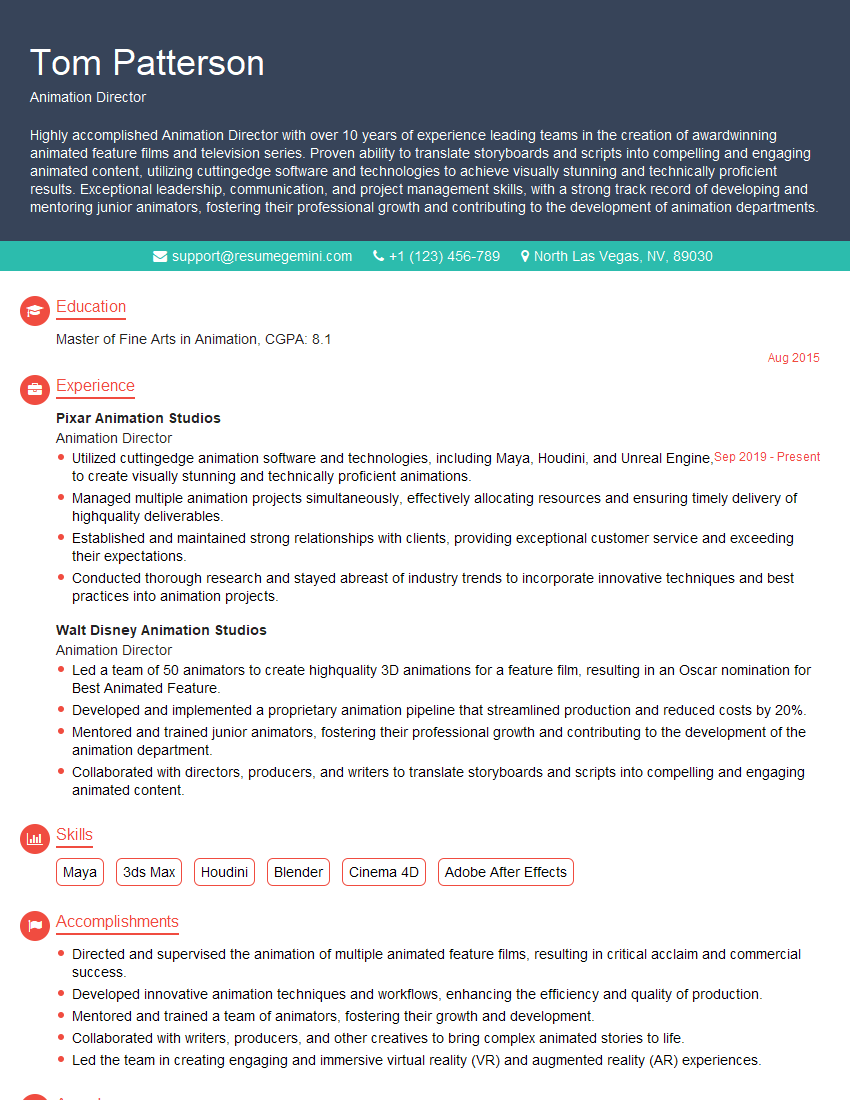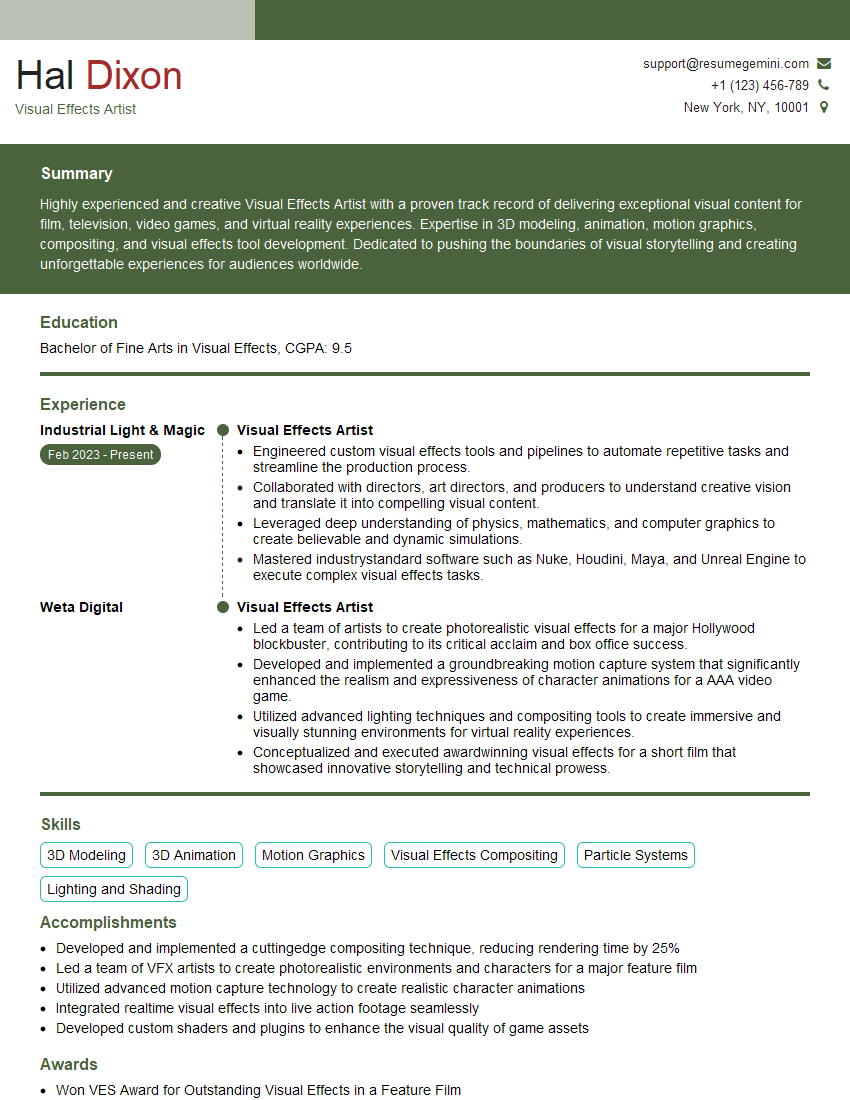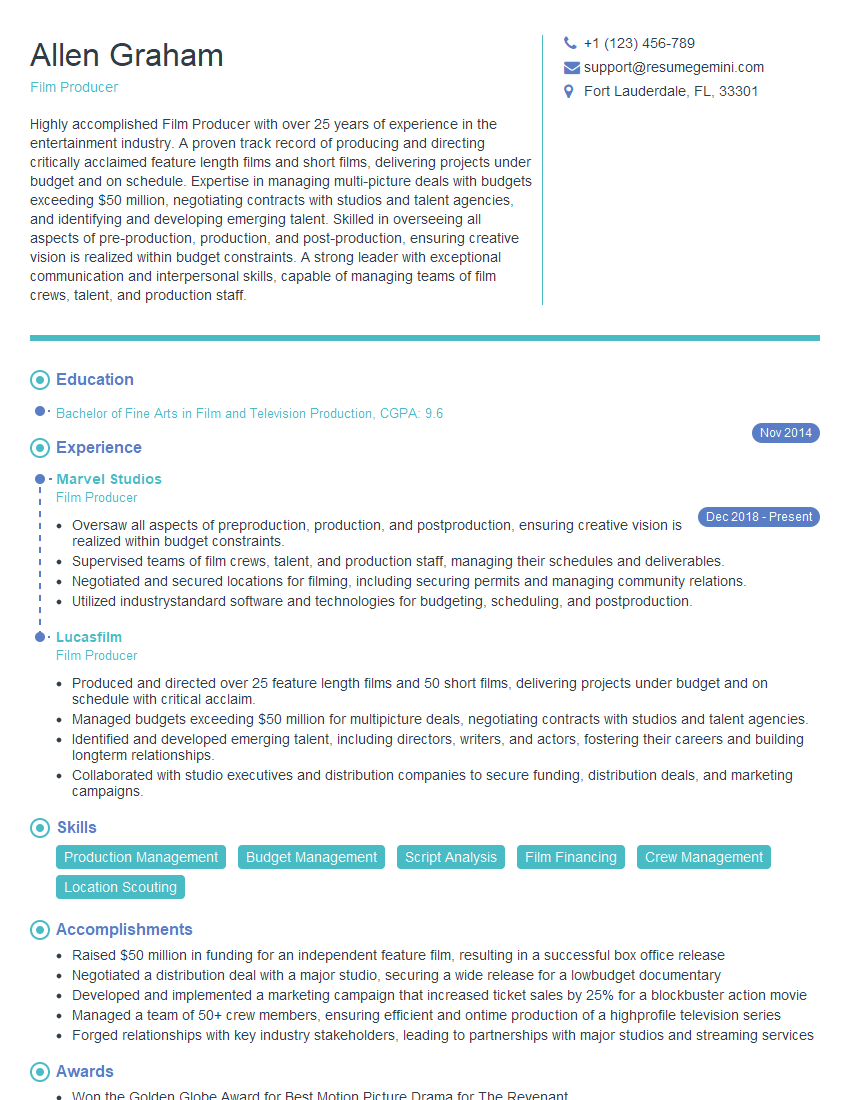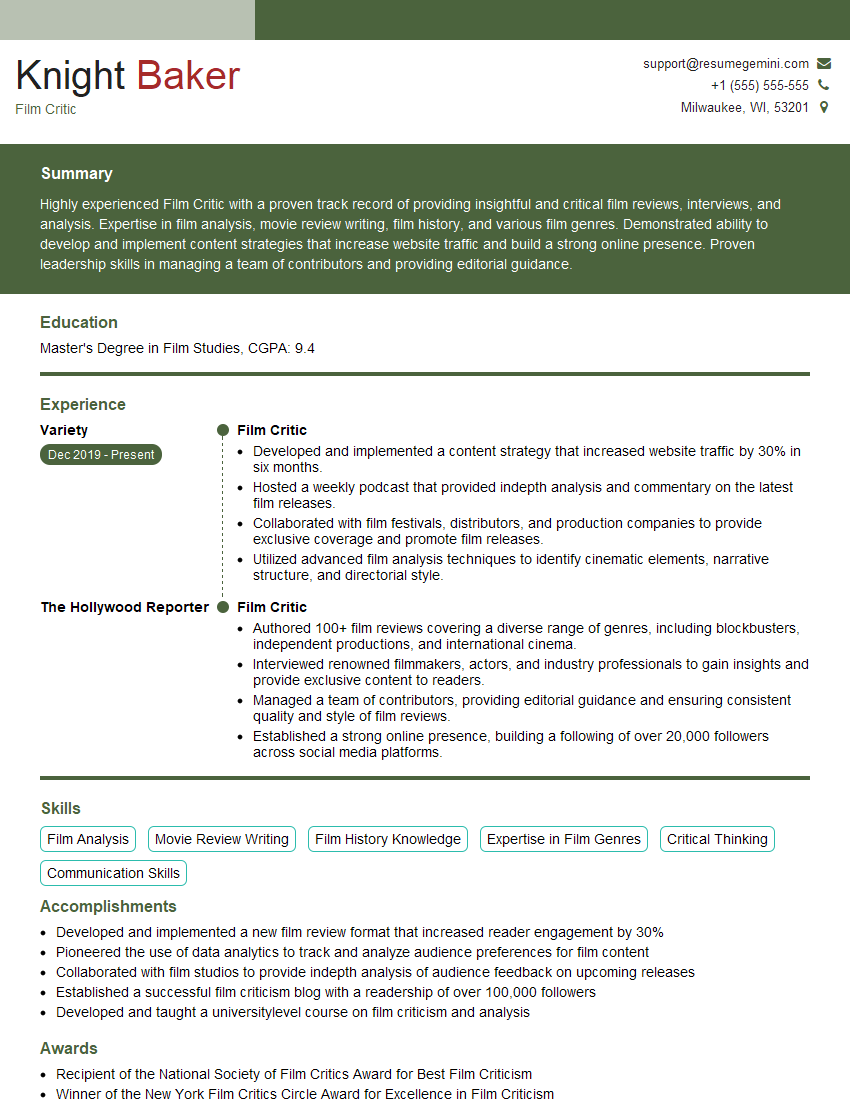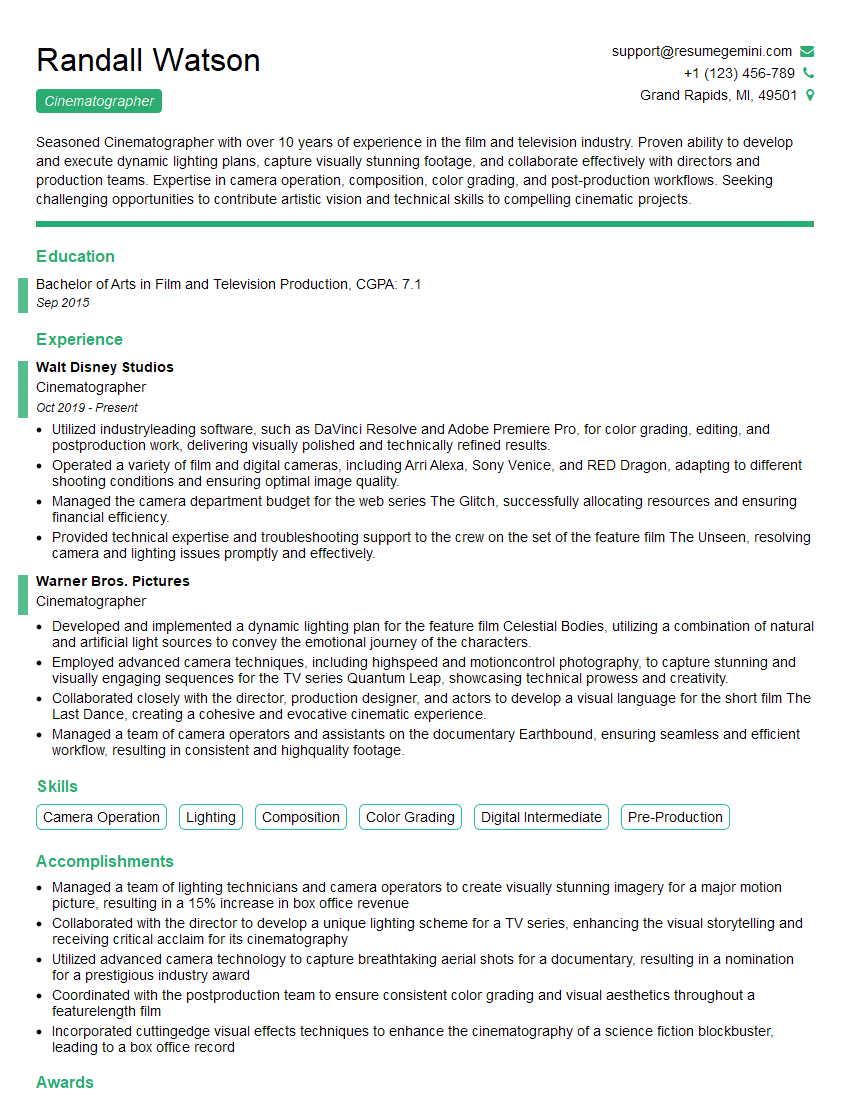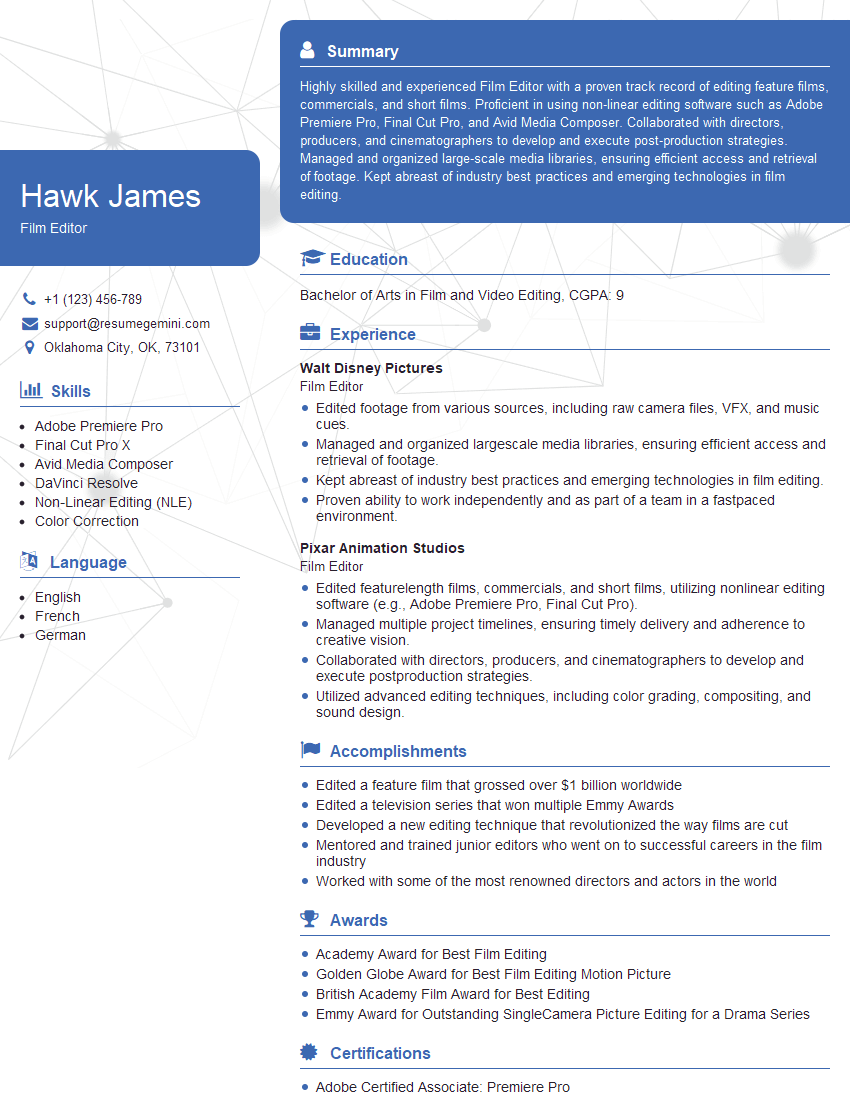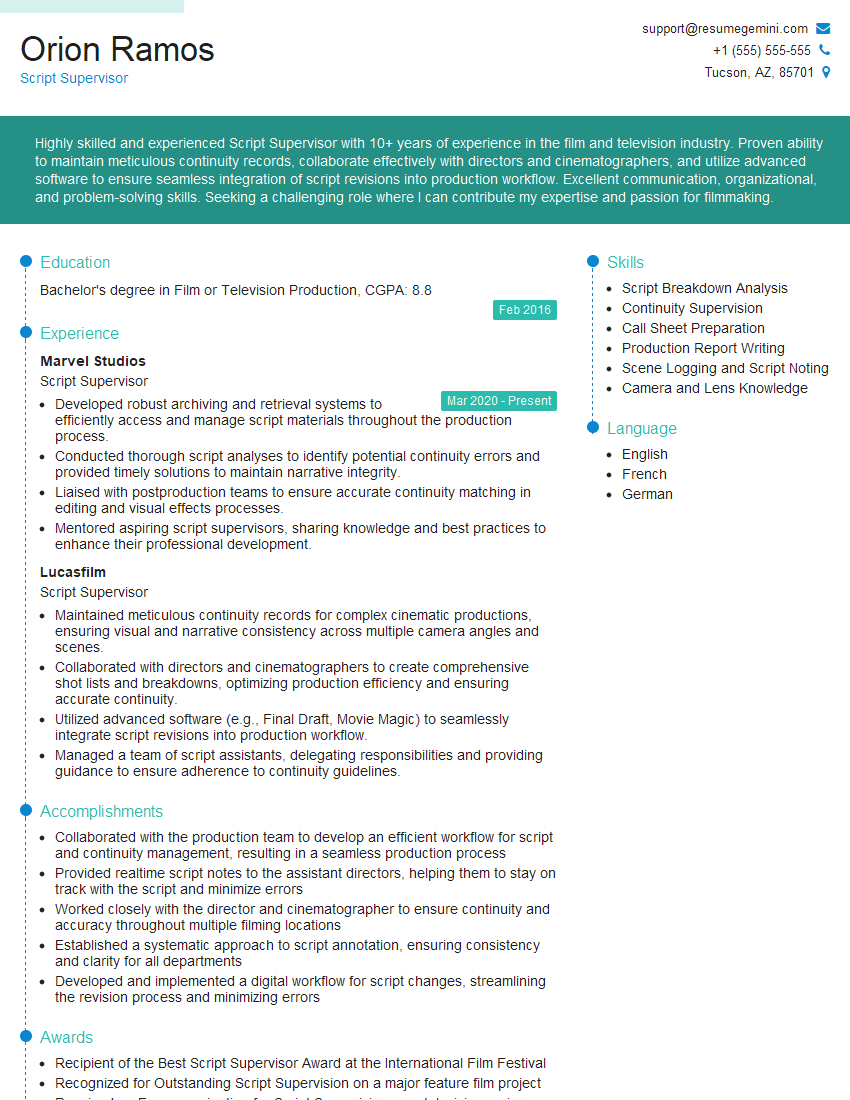The right preparation can turn an interview into an opportunity to showcase your expertise. This guide to Understanding Film Language interview questions is your ultimate resource, providing key insights and tips to help you ace your responses and stand out as a top candidate.
Questions Asked in Understanding Film Language Interview
Q 1. Explain the concept of mise-en-scène and its key components.
Mise-en-scène is a French term that literally translates to “placing on stage.” In filmmaking, it refers to everything visible within the frame—a meticulously crafted visual composition that contributes significantly to the film’s narrative and emotional impact. Think of it as the director’s meticulously planned stage design for the camera.
- Setting: The location, environment, and its inherent characteristics (e.g., a bustling city street versus a quiet forest). Consider how the setting reflects the characters’ emotional states or the story’s themes.
- Props: Objects within the scene that contribute to the narrative or character development. A worn-out teddy bear might signify childhood trauma, whereas a gleaming trophy speaks of ambition.
- Costume and Makeup: Clothing, hairstyles, and makeup choices convey character personalities, social status, and even emotional states. A character’s ragged clothes might suggest poverty, while immaculate attire indicates wealth or power.
- Lighting: The use of light and shadow to create mood, highlight certain elements, and guide the viewer’s eye. We’ll discuss lighting styles in more detail later.
- Composition: How elements are arranged within the frame to guide the viewer’s gaze and create visual balance or tension. We’ll cover composition techniques like the rule of thirds shortly.
- Acting Style: The performance style of actors within the scene and the interaction between them. This contributes to the storytelling and emotional impact of the scene.
For example, in the film Citizen Kane, Orson Welles masterfully uses mise-en-scène to convey the character’s isolation and vast wealth through his sprawling mansion and the carefully composed shots emphasizing his loneliness within his opulent surroundings.
Q 2. Describe the difference between high-key and low-key lighting.
High-key and low-key lighting are two contrasting approaches to illumination that dramatically affect the mood and atmosphere of a scene.
- High-key lighting is characterized by bright, even illumination with few shadows. This creates a cheerful, optimistic, and often upbeat atmosphere. Think of romantic comedies or bright, sunny daytime scenes. The contrast between light and dark is minimal.
- Low-key lighting uses strong contrasts between light and shadow, with significant areas of darkness. This generates a more mysterious, suspenseful, or dramatic feel, often used in thrillers, horror films, or noir cinema. Deep shadows obscure details, heightening tension and creating a sense of unease.
Consider a scene in a brightly lit hospital room (high-key) versus a shadowy alleyway at night (low-key). The lighting immediately sets the tone and informs the audience’s expectations.
Q 3. How does shot composition (e.g., rule of thirds, leading lines) impact storytelling?
Shot composition is crucial in guiding the viewer’s eye and subtly influencing their understanding of the scene. Two key techniques are the rule of thirds and leading lines.
- Rule of thirds: This principle suggests dividing the frame into nine equal parts using two equally-spaced horizontal and two equally-spaced vertical lines. Placing key elements along these lines or at their intersections creates a more visually appealing and balanced composition. It avoids placing the subject dead center, making the image more dynamic.
- Leading lines: These are lines within the frame (roads, fences, rivers) that naturally draw the viewer’s eye towards a specific point of interest, such as a character or object, creating a sense of depth and guiding the narrative flow.
Imagine a shot of a character standing at the end of a long road (leading lines). The road leads the viewer’s eye to the character, emphasizing their isolation or vulnerability. Placing the character slightly off-center (rule of thirds) further enhances the visual impact.
Q 4. Analyze the use of color palettes in conveying mood and emotion in a film.
Color palettes are powerful tools for conveying mood, emotion, and even symbolic meaning. The use of color is a deliberate choice made by the cinematographer and director to enhance the storytelling.
- Warm colors (reds, oranges, yellows) often evoke feelings of warmth, energy, excitement, or anger.
- Cool colors (blues, greens, purples) tend to suggest calmness, sadness, tranquility, or mystery.
- Desaturated colors (muted, faded tones) might represent bleakness, despair, or nostalgia.
- Vibrant colors can signal joy, vibrancy, or even artificiality.
For example, a film might use warm colors during happy scenes and shift to cool colors during moments of sadness or danger. The Wizard of Oz famously utilizes a vibrant color palette in Oz after the initial sepia-toned Kansas sequences, visually representing the transition to a magical and fantastical world.
Q 5. Discuss the narrative function of different camera angles (e.g., high angle, low angle).
Camera angles significantly impact how we perceive characters and their relationships within the narrative.
- High-angle shots look down on the subject, often portraying them as weak, vulnerable, or insignificant. This angle can emphasize the power of someone or something else in the scene.
- Low-angle shots shoot upwards towards the subject, making them appear powerful, dominant, or imposing. This angle can make the subject feel larger-than-life.
- Eye-level shots provide a neutral perspective, establishing a more relatable connection with the character.
Consider a scene where a powerful CEO is shown in a low-angle shot, emphasizing their authority. Conversely, a vulnerable character might be depicted in a high-angle shot, showcasing their weakness. The choice of angle profoundly alters audience perception.
Q 6. Explain the role of editing in pacing and building suspense.
Editing is the art of assembling shots to create a cohesive narrative. It plays a crucial role in manipulating pacing and building suspense.
- Pacing: Rapid cuts create a sense of urgency and excitement, while longer takes establish a slower, more contemplative mood. The rhythm of editing directly impacts the emotional tempo of the film.
- Suspense: Editing can build suspense through techniques like cross-cutting (alternating between two separate scenes happening concurrently), jump cuts (abrupt transitions creating discontinuity), and withholding information to create anticipation.
Think of a chase scene where rapid cuts convey the frantic energy. In contrast, a suspenseful scene might use slow, deliberate cuts to build tension before a sudden, impactful moment.
Q 7. What are the different types of editing transitions and their effects?
Editing transitions connect shots and influence the viewer’s experience. Various transitions create distinct effects.
- Cut: The simplest transition, an instantaneous change from one shot to another. It’s the most common transition.
- Fade-in/Fade-out: A gradual darkening or brightening of the screen, often used to transition between scenes or indicate the passage of time.
- Dissolve: One image gradually blends into the next, creating a smoother transition and often suggesting a connection between the two scenes.
- Wipe: A line moves across the screen, replacing one shot with another. It can feel more theatrical or stylized.
- Jump cut: A jarring, abrupt transition that skips a portion of time or action. This can be used to create a sense of disorientation or emphasize a specific point.
A fade-out to black followed by a fade-in to a new scene clearly indicates a significant time jump. A dissolve suggests a smooth, more seamless transition between related moments.
Q 8. How does sound design contribute to the overall cinematic experience?
Sound design is far more than just adding music and dialogue; it’s a crucial element shaping the audience’s emotional response and understanding of a film. It contributes to the overall cinematic experience by creating atmosphere, enhancing narrative, and guiding the viewer’s attention. Think of the eerie silence before a jump scare, the subtle creak of a door building suspense, or the roar of a crowd during a triumphant moment – these are all examples of sound design at work.
Effective sound design can amplify the impact of visual storytelling, creating a layered and immersive experience. For instance, a quiet, intimate scene might be underscored by delicate piano music to heighten the emotional vulnerability, while an action sequence might utilize a complex soundscape of explosions, gunfire, and screaming to create chaos and excitement. Sound can also provide crucial information that visuals alone might miss, guiding the audience’s perception and adding depth to the narrative.
Consider the film ‘Apocalypse Now’. The film’s use of Wagnerian opera alongside the chaotic sounds of the Vietnam War creates a dissonance that perfectly reflects the film’s themes of madness and the disintegration of moral order. The sound design is not merely background noise; it’s an active participant in the storytelling, shaping our emotional response to the unfolding events.
Q 9. Differentiate between diegetic and non-diegetic sound.
Diegetic and non-diegetic sound are two fundamental categories in film sound. Diegetic sound originates from within the film’s world. This means the characters in the film can hear it. Examples include dialogue, sounds of footsteps, a car horn, or music playing from a radio within the scene. It’s part of the fictional reality.
Non-diegetic sound, on the other hand, exists outside the film’s world. The characters cannot hear it. This category includes the film score, voiceover narration, and sound effects added during post-production to enhance the mood or create dramatic emphasis. It’s a tool for the filmmaker to communicate directly with the audience.
Consider a scene where two characters are having a tense conversation in a dimly lit room. The diegetic sounds might be their hushed voices and the occasional creak of a floorboard. The non-diegetic sound might be a low, ominous string section underscoring the tension, conveying a sense of foreboding to the audience that the characters themselves may not yet perceive.
Q 10. Explain the use of symbolism and metaphor in filmmaking.
Symbolism and metaphor are powerful tools filmmakers use to add layers of meaning and depth to their narratives, moving beyond literal representation to explore themes and ideas indirectly. Symbolism involves using objects, characters, settings, or events to represent abstract concepts or ideas. For example, a recurring image of a bird might symbolize freedom, while a wilting flower could represent death or decay.
Metaphor is a comparison between two unlike things, implying a similarity between them. It works on a more implicit level than symbolism. A character struggling against a stormy sea might metaphorically represent their inner struggle with overwhelming challenges.
In ‘The Wizard of Oz’, the yellow brick road symbolizes the journey towards self-discovery and the fulfillment of one’s dreams. The Wicked Witch of the West can be seen as a metaphor for the societal pressures and obstacles Dorothy faces on her journey. The effective use of symbolism and metaphor makes a film richer and more open to interpretation, allowing for a deeper engagement with the story and its themes.
Q 11. Analyze how a film’s narrative structure affects audience engagement.
A film’s narrative structure significantly influences audience engagement. The way a story is told—its pacing, plot points, and overall architecture—determines how effectively a film captivates and holds the viewer’s attention. A well-structured narrative keeps the audience invested, curious, and emotionally connected.
Linear narratives, which unfold chronologically, are generally easier to follow and often create a sense of predictability. Non-linear narratives, however, employing flashbacks, flashforwards, or multiple timelines, can be more challenging but also more rewarding, offering layers of complexity and depth. They require greater audience participation and interpretation, making the viewing experience more intellectually engaging.
For instance, a film like ‘Pulp Fiction’ utilizes a non-linear structure to create a sense of mystery and suspense, keeping the audience guessing about the relationships between the characters and the overall plot. This unconventional structure increases audience engagement because it demands active participation in deciphering the timeline and understanding the interconnections between seemingly disparate events.
Q 12. Describe the importance of continuity editing in maintaining narrative coherence.
Continuity editing is a fundamental technique in filmmaking that ensures a smooth and logical flow of the narrative. It relies on several principles to maintain narrative coherence and prevent jarring transitions. These principles include:
- Matching Action: Cutting from one shot to another at the point of a continuous action, creating a seamless transition.
- Eye-Line Match: Showing a character looking off-screen, then cutting to what they are looking at, establishing a clear visual connection.
- 180-Degree Rule: Staying on one side of an imaginary line between two characters, maintaining spatial consistency and preventing disorientation.
- Shot/Reverse Shot: Alternating between shots of two characters in conversation, conveying the interaction naturally.
The purpose of continuity editing is to create a believable and engaging narrative experience that feels natural and avoids disrupting the viewer’s immersion in the story. If continuity is broken, the audience is pulled out of the film’s world, hindering their engagement with the narrative.
Q 13. How does framing influence the viewer’s perception of characters and events?
Framing, the way a shot is composed within the frame, profoundly impacts how the viewer perceives characters and events. The filmmaker uses framing to control the audience’s perspective, emphasizing certain elements and de-emphasizing others.
High-angle shots can make characters appear vulnerable or insignificant, while low-angle shots can make them seem powerful or threatening. Extreme close-ups can focus on minute details, revealing subtle emotions or creating intense intimacy, whereas wide shots establish context and scale, revealing the relationship between characters and their environment.
Think of a scene where a lone figure is framed in the center of a vast, desolate landscape. The wide shot emphasizes the character’s isolation and vulnerability, conveying a feeling of loneliness and insignificance. Conversely, a close-up on the character’s determined expression might counter this, showing their resilience and inner strength. The interplay of these framing techniques is how filmmakers shape the viewers’ understanding of the character and their circumstances.
Q 14. Explain the techniques used to create depth of field in a shot.
Depth of field refers to the area of the image that appears in sharp focus. Controlling depth of field is a crucial aspect of cinematography as it allows filmmakers to direct the viewer’s attention and shape the visual narrative.
The primary technique used to control depth of field is adjusting the aperture of the camera lens. A wide aperture (low f-stop number, e.g., f/1.4) results in a shallow depth of field, where only a small portion of the image is in sharp focus, blurring the background. A narrow aperture (high f-stop number, e.g., f/16) produces a large depth of field, rendering both foreground and background in sharp focus.
Other factors influencing depth of field include the lens’s focal length (longer lenses generally produce shallower depth of field), the distance between the camera and the subject, and the sensor size (larger sensors generally yield shallower depth of field). By manipulating these factors, filmmakers can create visually striking effects, drawing the eye to specific elements within the scene and creating a sense of three-dimensionality even in a two-dimensional medium.
Q 15. What are the different types of camera movements and their purposes?
Camera movement is a crucial element of filmmaking, influencing pacing, audience perspective, and emotional impact. Different movements serve distinct purposes.
- Pan: The camera pivots horizontally on a fixed axis, revealing a wider view or following action. Think of a sweeping shot across a vast landscape in a Western, establishing the setting.
- Tilt: The camera pivots vertically on a fixed axis, often used to reveal scale or emphasize a character’s emotion. Imagine a low-angle tilt up to a towering building to show power or a high-angle tilt down to a vulnerable character.
- Dolly/Tracking Shot: The camera moves smoothly along a track, either following a subject or creating a sense of movement within the scene. Consider a dolly shot following a character walking down a street, creating intimacy.
- Zoom: The camera lens changes focal length, bringing the subject closer or farther away. Zooming in can heighten tension, while zooming out can broaden perspective. A fast zoom can evoke anxiety.
- Crane Shot: The camera moves vertically, often on a crane, offering a dynamic perspective change. This might be used to show a character’s journey from a low point to a high point.
- Steadicam Shot: A camera operator uses a stabilizing device to create smooth, flowing movement, even while walking or running. This allows for immersive POV shots or fluid action sequences.
- Handheld Shot: The camera is held by the operator, creating a shaky, often subjective feel. This creates a sense of immediacy and realism, often used in documentaries or action scenes.
The choice of camera movement significantly impacts a film’s visual storytelling. A static shot can emphasize stillness and contemplation, while dynamic movements can create a sense of urgency or excitement.
Career Expert Tips:
- Ace those interviews! Prepare effectively by reviewing the Top 50 Most Common Interview Questions on ResumeGemini.
- Navigate your job search with confidence! Explore a wide range of Career Tips on ResumeGemini. Learn about common challenges and recommendations to overcome them.
- Craft the perfect resume! Master the Art of Resume Writing with ResumeGemini’s guide. Showcase your unique qualifications and achievements effectively.
- Don’t miss out on holiday savings! Build your dream resume with ResumeGemini’s ATS optimized templates.
Q 16. How does the use of lighting affect character development?
Lighting is a powerful tool for shaping character development, influencing mood and revealing personality traits. It’s often more than just illuminating a scene; it’s a form of visual storytelling.
- High-Key Lighting: Bright, even illumination creates a positive, upbeat atmosphere, often associated with optimistic or innocent characters. Think of classic Hollywood romances.
- Low-Key Lighting: Strong contrasts between light and shadow create a mysterious or suspenseful mood, frequently used to portray villains or characters with hidden depths. Film noir often employs this technique.
- Chiaroscuro: Dramatic use of light and shadow to highlight specific features and create a three-dimensional effect. This can emphasize a character’s internal conflict or their manipulative nature.
- Backlighting: Light shines from behind the subject, creating a silhouette or halo effect. This can portray characters as mysterious, ethereal, or even dangerous.
Consider the character of a brooding detective in a noir film. Low-key lighting, with deep shadows obscuring parts of his face, immediately suggests mystery and internal conflict. In contrast, a bright, high-key scene featuring a joyful protagonist emphasizes their optimistic personality.
Q 17. Discuss the role of visual storytelling in conveying complex themes.
Visual storytelling is the art of conveying narrative, emotion, and themes without relying heavily on dialogue. It’s crucial for expressing complex ideas in a compelling way.
Consider the film ‘Arrival’. The use of visual metaphors – circular imagery, non-linear storytelling – effectively depicts the complex themes of communication, time, and understanding other perspectives. The visual language guides the audience through the abstract concepts more effectively than dialogue alone could.
Another example is ‘Schindler’s List’. The stark black and white cinematography, punctuated by a single burst of color (a girl in a red coat), powerfully conveys the stark reality of the Holocaust and the significance of the girl’s fate. The visual language amplifies the thematic depth.
Visual storytelling uses composition, camera angles, color palettes, and editing to convey meaning. This allows filmmakers to explore complex issues – themes of alienation, societal pressures, environmental destruction – through a more impactful, multi-layered approach than pure narration.
Q 18. Analyze how a film’s genre conventions shape its narrative and visual style.
Genre conventions significantly shape a film’s visual style and narrative structure. They establish audience expectations and dictate certain storytelling approaches.
- Horror: Often utilizes dark, shadowy lighting, jump scares, extreme close-ups, and unsettling sound design to create fear and suspense. The narrative typically centers around a threat, suspense, and a desperate struggle for survival.
- Romance: Often employs soft lighting, warm colors, close-up shots emphasizing intimacy, and romantic music to create a sense of love and longing. The narrative focuses on relationships, emotions, and romantic gestures.
- Action: Emphasizes rapid editing, dynamic camera movements, and explosive special effects to create a sense of excitement and energy. The narrative typically revolves around chases, fights, and high stakes.
- Western: Often uses wide shots of vast landscapes, emphasizing the loneliness and scale of the environment. The narrative usually involves themes of heroism, justice, and the conflict between civilization and wilderness.
Knowing the genre conventions allows filmmakers to both fulfill audience expectations and subvert them. A horror film that subverts genre conventions might use bright lighting to create an unsettling feeling of normalcy masking danger.
Q 19. Explain the concept of cinematic point of view and its impact on the audience.
Cinematic point of view refers to the perspective from which the story is told. It significantly influences how the audience connects with the characters and events.
- Objective POV: The camera acts as a neutral observer, presenting events without bias. This creates a sense of distance and allows the audience to draw their own conclusions.
- Subjective POV: The camera adopts the perspective of a character, showing the world as they see and experience it. This creates intimacy and empathy, allowing the audience to understand the character’s thoughts and feelings.
- Third-Person POV: The camera observes the events from an external perspective. This can vary from a more distant, omniscient POV to a more focused POV on a particular character.
- First-Person POV: The audience experiences the story directly through the eyes of a character. Often achieved using handheld camera work or first-person shots
For instance, a subjective POV shot during a character’s panic attack immediately immerses the audience in their experience. In contrast, an objective POV shot during a crime scene provides a more detached, analytical perspective.
Q 20. How does the use of montage create meaning and emotion in a film?
Montage is a powerful editing technique that juxtaposes short shots to create a condensed narrative or convey a complex emotion. It transcends simple chronological storytelling.
Consider a montage of shots showing a character’s training regime in a sports film. Short, fast cuts showing intense exercise, sweat, determination, and the eventual triumph in a competition. The montage conveys the character’s dedication and hard work far more effectively than a long, drawn-out scene.
Another example is a montage depicting the passage of time. Quick cuts showing a character aging, seasons changing, or a city evolving conveys the changes over a long span more efficiently and with stronger emotion than describing them.
Montage sequences can also condense emotionally complex moments, condensing years of heartbreak into a series of fleeting visuals, underscoring the emotional weight more powerfully than extensive dialogue.
Q 21. Describe the relationship between cinematography and mise-en-scène.
Cinematography and mise-en-scène are intertwined aspects of filmmaking that work together to create a film’s visual world. They are inseparable, although often discussed separately.
Mise-en-scène encompasses everything visible within the frame – set design, costumes, actor positioning, lighting, and composition. It is the director’s staging of the scene.
Cinematography is the art of capturing the mise-en-scène on film or digitally. It involves camera angles, movements, framing, focus, and the use of lenses. The cinematographer translates the director’s vision into a visual reality.
Consider a scene with a character sitting alone in a dimly lit room. The mise-en-scène includes the dark room, the character’s somber clothing, and their posture. The cinematography involves the camera angle (perhaps a low angle to make the character seem vulnerable), the lighting (low-key to emphasize shadows and mood), and the framing (a tight close-up to highlight emotion).
Essentially, mise-en-scène provides the elements, and cinematography captures and presents them, shaping the audience’s perception and experience of the scene. They are both integral parts of creating a film’s visual language.
Q 22. Analyze how sound effects and music contribute to the creation of mood and atmosphere.
Sound effects and music are integral to a film’s mood and atmosphere, working in tandem to evoke specific emotions and enhance the narrative. They don’t merely accompany the visuals; they actively shape our understanding and experience.
Sound Effects: These are diegetic (sounds originating from within the film’s world) or non-diegetic (sounds added for the audience’s benefit). A creaking door might enhance suspense (diegetic), while a sudden, loud crash of cymbals might punctuate a shocking moment (non-diegetic). The subtle use of ambient sounds – the rustle of leaves, the distant hum of a city – can build a believable and immersive environment. Think of the ominous soundscapes in a horror film, effectively contributing to the overall sense of dread.
Music: Often non-diegetic, music is a powerful tool for manipulating emotions. A soaring orchestral score can evoke feelings of grandeur and triumph, while a dissonant melody might create tension and anxiety. Consider the use of leitmotifs – recurring musical themes associated with specific characters or ideas – which deepen thematic resonance and emotional impact. The choice of instrumentation also plays a role. A melancholic piano piece will evoke a different feeling than a driving rock song.
Interaction: The interplay between sound effects and music is crucial. Music can amplify the impact of sound effects, or vice-versa. A quiet, suspenseful musical score can be heightened by a sudden, sharp sound effect, creating a moment of heightened tension. In essence, sound design is a masterful orchestration of sonic elements working together to create a holistic emotional experience for the viewer.
Q 23. Discuss the impact of different aspect ratios on the visual experience.
Aspect ratio, the relationship between the width and height of a film image, significantly influences the visual experience by impacting the composition, framing, and overall feel of a film. Different ratios convey distinct stylistic choices and emotional tones.
Traditional Academy Ratio (1.37:1): This older ratio feels more intimate and often suited to character-driven narratives. It fills the screen less, drawing the eye to the center of the frame.
Widescreen Ratios (e.g., 1.85:1, 2.35:1, 2.39:1): These ratios are wider, offering a greater sense of scope and grandeur. They’re often favored for action, epic, or landscape-heavy films, emphasizing the horizontal expanse. The wider frame allows for more expansive compositions and can make the characters feel smaller in relation to their environment, creating a sense of scale and isolation.
Square or near-square formats (1:1 or close): These are becoming more popular. They provide a unique perspective that some feel is more balanced and closer to the viewer, evoking a direct, almost intimate connection.
Impact on Storytelling: The chosen aspect ratio directs the viewer’s gaze and influences how they perceive the scene. A wide ratio might emphasize the vastness of a desert landscape, whereas a narrower ratio could focus attention on a character’s emotional state. Cinematographers deliberately utilize aspect ratios to reinforce the film’s themes and style.
Q 24. Explain how film techniques are used to create realism or fantasy.
Film techniques are powerfully employed to shape the audience’s perception of reality, convincingly portraying either realism or fantasy.
Creating Realism: Techniques used to enhance realism aim for verisimilitude – a convincing semblance of reality. This often involves:
- Naturalistic Lighting: Using lighting that mimics natural light sources like sunlight or lamplight.
- Handheld Camera Work: This creates a sense of immediacy and can be utilized to mimic a documentary style or portray chaotic events.
- Long Takes: Extended shots without cuts can convey a sense of unbroken time and space, enhancing the viewer’s immersion.
- Location Shooting: Filming in real-world environments adds authenticity.
- Realistic Sound Design: Using sounds that accurately reflect the environment and actions.
Creating Fantasy: Fantasy films use techniques to construct a believable world outside of reality. This can involve:
- Special Effects: CGI, practical effects, and other special techniques are used to create impossible or fantastical elements.
- Stylized Lighting and Color Palettes: Using specific lighting techniques and color grading to build a unique visual world.
- Unconventional Camera Angles and Movements: Using unusual angles and movements can disorient and convey a sense of the surreal.
- Surreal Set Design and Costume Design: These play a pivotal role in crafting a visually distinct, fantastical environment.
Examples: A film like 12 Angry Men relies heavily on realism, utilizing minimal sets and naturalistic lighting. Conversely, a film like The Lord of the Rings leverages extensive special effects, stylized sets, and costumes to create a fully realized fantasy world.
Q 25. How does the choice of film stock or digital format affect the look of a film?
The choice between film stock (celluloid) and digital formats profoundly impacts a film’s look, affecting its grain, color palette, and overall aesthetic.
Film Stock: Film stock possesses a unique grain structure and organic texture that imparts a particular visual character. Different stocks offer varying degrees of grain, contrast, and color saturation. For example, Kodak Vision3 500T provides a relatively fine grain and rich color, while Kodak Vision2 500T offers a more pronounced grain, lending a more vintage or gritty look. The physical nature of film also introduces unpredictable variations, resulting in unique textures and imperfections that are highly sought after by some filmmakers. It can even affect the color reproduction with certain stocks producing warmer or cooler tones.
Digital Formats: Digital formats offer greater flexibility and control. They lack the inherent grain of film, but sophisticated software allows filmmakers to simulate various film looks or create entirely unique aesthetic qualities. Digital also allows for more precise color correction and grading, offering a wider range of creative possibilities. It also permits easy adjustments and corrections during post-production, offering a level of flexibility unavailable with film. However, digital can appear overly sharp and lacking the organic imperfections that some filmmakers find desirable in film.
Impact on Style: The choice directly influences the visual style and often reflects the film’s tone and genre. A gritty crime thriller might benefit from the texture of film stock, while a polished science fiction film might favor the crisp clarity of digital. The decision is ultimately a stylistic one, balancing technical capabilities with artistic vision.
Q 26. Analyze the use of visual metaphors in a specific film.
Let’s analyze the use of visual metaphors in Citizen Kane. The film masterfully employs visual metaphors to reflect the central theme of the elusive nature of truth and the decay of Kane’s empire.
The Rosebud Sleigh: The iconic sled, ‘Rosebud’, is a powerful visual metaphor for Kane’s lost innocence and the unattainable happiness of his childhood. Its presence throughout the film, finally revealed at the end, anchors the entire narrative and symbolizes the emotional core of Kane’s life. The sled’s simple image contrasts sharply with Kane’s later opulence, visually signifying the contrast between his humble beginnings and his ambitious, yet ultimately hollow, adult life.
The Vastness of Xanadu: Xanadu, Kane’s sprawling mansion, is another visual metaphor for his power and wealth, but also for his isolation and loneliness. Its vast emptiness mirrors the emotional emptiness within Kane, highlighting the hollowness behind his outward success. The decaying grandeur of Xanadu visually represents the crumbling of Kane’s empire and the fragility of his achievements.
Mise-en-scène: The overall composition of the shots, including set design, lighting, and character placement, also works as a visual metaphor. Deep focus cinematography at times showcases both Kane and his environment simultaneously to demonstrate the symbiotic relationship between the man and his possessions; visually highlighting the profound impact they have upon each other.
Meaning: The cumulative effect of these visual metaphors creates a complex and layered narrative, inviting multiple interpretations of Kane’s life and the nature of power and ambition. The visual storytelling in Citizen Kane surpasses mere description, delivering a rich, powerful message about the elusive nature of truth and the complexities of the human experience.
Q 27. Discuss the impact of post-production techniques on the final product.
Post-production techniques significantly shape the final product, extending far beyond simple editing. They encompass a wide range of processes that dramatically affect the film’s look, sound, and overall impact.
Editing: The assembly and sequencing of shots is crucial for pacing, narrative flow, and emotional impact. Choices in cuts, transitions, and rhythm create the film’s unique narrative voice. Modern software gives incredible control over these aspects.
Color Grading and Correction: Manipulating the film’s color palette can drastically change its mood and atmosphere. A warmer color grading can create a more intimate feel, while a cooler palette may convey coldness or isolation. This is vital for consistency and aesthetic coherence.
Visual Effects (VFX): VFX ranges from minor touch-ups to elaborate creations of entire worlds. It’s critical for many genres, enhancing realism or building fantastical elements. CGI techniques, compositing, and motion tracking are all major parts of this.
Sound Design and Mixing: This involves adjusting the levels, frequencies, and spatial placement of various sounds, enhancing clarity and creating an immersive auditory experience. This plays a major role in conveying mood and enhancing the narrative.
Music Scoring and Sound Editing: The composition and placement of music create emotional impact and underscore narrative moments. Sound editing creates cohesive, natural-sounding dialogues that enhance cinematic immersion.
Impact: Post-production is the stage where the film transforms from raw footage into a refined artistic product. The skillful application of these techniques creates a coherent whole that effectively communicates the filmmaker’s vision to the audience.
Q 28. Explain how understanding film language helps you create more effective visual storytelling.
Understanding film language is fundamental to effective visual storytelling. It provides a framework for making conscious choices that enhance narrative clarity, emotional impact, and audience engagement.
Narrative Structure: Understanding shot composition, editing techniques, and pacing enables constructing a story that flows logically and engages the audience’s attention. For instance, using close-ups to emphasize emotional moments, or employing montage sequences to convey the passage of time.
Character Development: Shot selection, camera angles, and lighting can be used to reveal character traits and inner states. For instance, using low-angle shots to empower a character or high-angle shots to make them appear vulnerable.
Theme and Mood Creation: Color palettes, lighting, and sound design can be utilized to create a consistent thematic and emotional landscape. For instance, using muted colors to establish a somber mood or vibrant colors to evoke joy.
Audience Engagement: By using techniques like point-of-view shots, jump cuts, or other creative editing choices, a filmmaker can actively engage the audience by making them part of the narrative.
Practical Application: Understanding how the various elements of film language interact allows for deliberate and purposeful filmmaking, increasing the effectiveness of the storytelling process. It enables the creation of a unified and resonant cinematic experience.
Key Topics to Learn for Understanding Film Language Interview
- Mise-en-scène: Analyze how elements within the frame (setting, costumes, lighting, composition) contribute to narrative and meaning. Consider practical application in analyzing specific film scenes and explaining their impact.
- Cinematography: Understand camera angles, movement, lenses, and their effects on storytelling and audience experience. Be prepared to discuss how choices in cinematography shape emotional responses and thematic concerns.
- Editing: Explore different editing techniques (e.g., montage, parallel editing, jump cuts) and their impact on pacing, rhythm, and narrative structure. Practice analyzing the relationship between editing choices and overall film meaning.
- Sound Design: Discuss the role of diegetic and non-diegetic sound in creating atmosphere, emphasizing narrative points, and influencing audience perception. Consider how sound enhances or contradicts visual elements.
- Narrative Structure: Analyze different narrative structures (e.g., linear, non-linear, episodic) and how they affect the audience’s engagement with the story. Be ready to discuss the choices filmmakers make and their effect.
- Genre Conventions: Understand how genre conventions influence filmmaking choices and audience expectations. Be prepared to discuss how specific films subvert or uphold genre conventions.
- Auteur Theory and Film Criticism: Familiarize yourself with key theoretical concepts and approaches to film analysis. Develop the ability to articulate your own critical perspectives on film, supported by evidence.
Next Steps
Mastering the understanding of film language is crucial for career advancement in film criticism, production, analysis, and related fields. A strong understanding of these concepts demonstrates your analytical skills and passion for cinema. To enhance your job prospects, creating an ATS-friendly resume is essential. ResumeGemini is a trusted resource that can help you craft a compelling and effective resume that highlights your skills and experience. Examples of resumes tailored to Understanding Film Language are available within ResumeGemini to help guide you.
Explore more articles
Users Rating of Our Blogs
Share Your Experience
We value your feedback! Please rate our content and share your thoughts (optional).
What Readers Say About Our Blog
Hi, I represent an SEO company that specialises in getting you AI citations and higher rankings on Google. I’d like to offer you a 100% free SEO audit for your website. Would you be interested?
Hi, I represent an SEO company that specialises in getting you AI citations and higher rankings on Google. I’d like to offer you a 100% free SEO audit for your website. Would you be interested?
Dear Sir/Madam,
Do you want to become a vendor/supplier/service provider of Delta Air Lines, Inc.? We are looking for a reliable, innovative and fair partner for 2025/2026 series tender projects, tasks and contracts. Kindly indicate your interest by requesting a pre-qualification questionnaire. With this information, we will analyze whether you meet the minimum requirements to collaborate with us.
Best regards,
Carey Richardson
V.P. – Corporate Audit and Enterprise Risk Management
Delta Air Lines Inc
Group Procurement & Contracts Center
1030 Delta Boulevard,
Atlanta, GA 30354-1989
United States
+1(470) 982-2456

